When you need to control a single load from multiple locations, traditional wiring methods like 3-way and 4-way switches can quickly become complex. RIB® (Relay-In-a-Box®) relays from Functional Devices simplify this challenge by providing a reliable, versatile way to handle multi-location switching while integrating seamlessly with modern building systems.
Functional Devices has been a trusted name in building automation and electrical control products for over 50 years. Our RIB relays are designed for easy installation, dependable operation, and broad compatibility. Contact our team today to see how RIB relays can streamline your building automation.
Now let’s explore how RIB relays can be used as 3- or 4-way switches, why they simplify complex wiring, and how they can enhance flexibility in both new installations and retrofit applications.
Understanding 3-Way and 4-Way Switching
First things first. You need to understand the differences between 3- and 4-way switching before we can dive into the specifics of RIB relays.
A 3-way switch setup lets you control a single load, like a light fixture, from two different locations. A 4-way switch expands this concept to three or more locations, making it ideal for hallways, stairwells, or large open spaces where multiple control points are needed.
Traditionally, these setups require special wiring configurations and multiple switches, which can become cumbersome or expensive. By using RIB relays instead of conventional switches, you gain flexibility, reduce wiring complexity, and open the door for automation or remote control features not possible with standard switching methods.
How RIB Relays Provide a Solution
RIB relays can be implemented as 3- or 4-way switches and provide a superior alternative to traditional wiring methods. Any of our DPDT relays could be wired to act as a 4-way switch. Any of our SPDT relays could be wired to act as a 3-way switch.
DPDT Wiring Basics
To use a DPDT relay as a 4-way switch, the Normally Open (N/O) contact of pole one would be wired to the Normally Closed (N/C) contact of pole two. The N/C contact of pole one would wire to the N/O contact of pole two, like the RIB24P contacts in the Figure below.
How RIB Relay Coils and Contacts Control Power Flow
In the above diagram, none of the relay coils would be energized, and all their contacts would be in their normal state. This provides a continuous path through the Normally Closed contacts, and the Load is powered. Let's say that Relay #2 has its coil energized. At that point, the relay contacts would change state. There will now be continuity between the Org and Yel wires, instead of the Blu and Yel wires. This is shown in the next diagram.
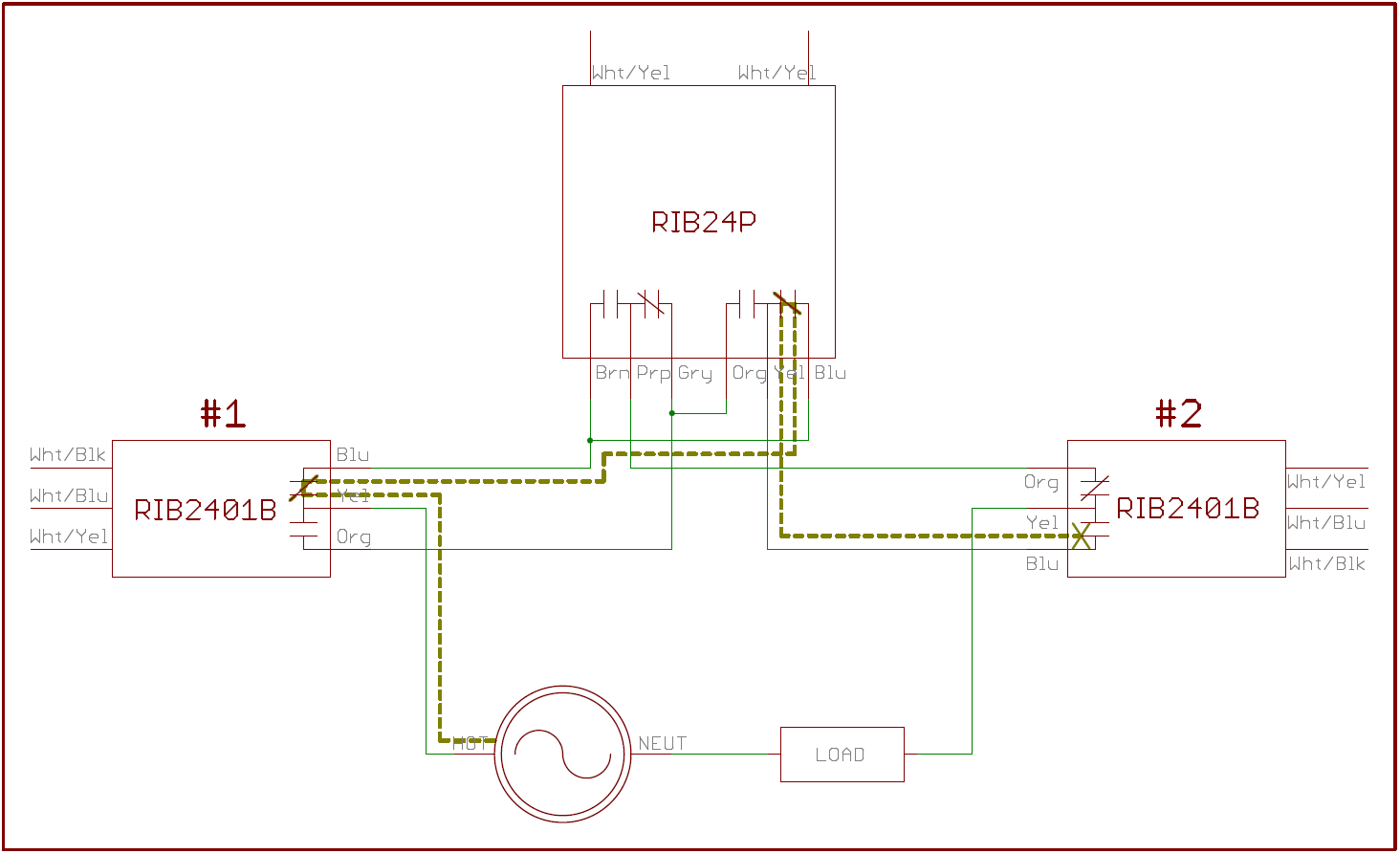
With Relay #2 energized, as above, the path from the source to the Load has been broken, and the Load would turn OFF. If Relay #1 would have been energized instead of Relay #2, the path for electrical flow would be as shown in the next diagram.
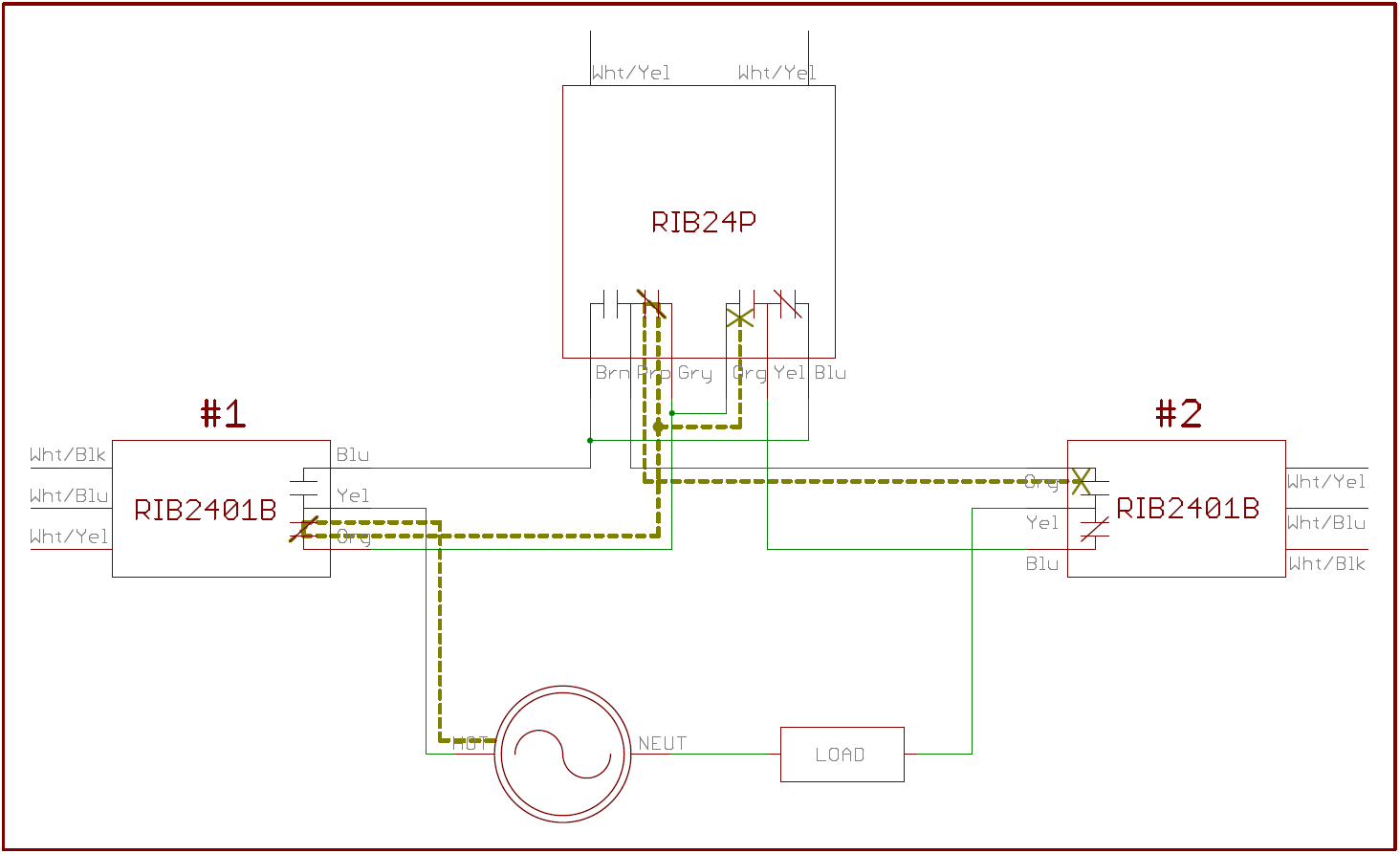
Since the contacts on Relay #1 changed state, there is a new path through its N/O contact to the RIB24P. However, there is no longer a complete path from the source to the Load, and it will not be powered. If RIB24P had been energized instead of Relay #1 or #2, the Load would also be OFF. This can be seen in the Figure below.
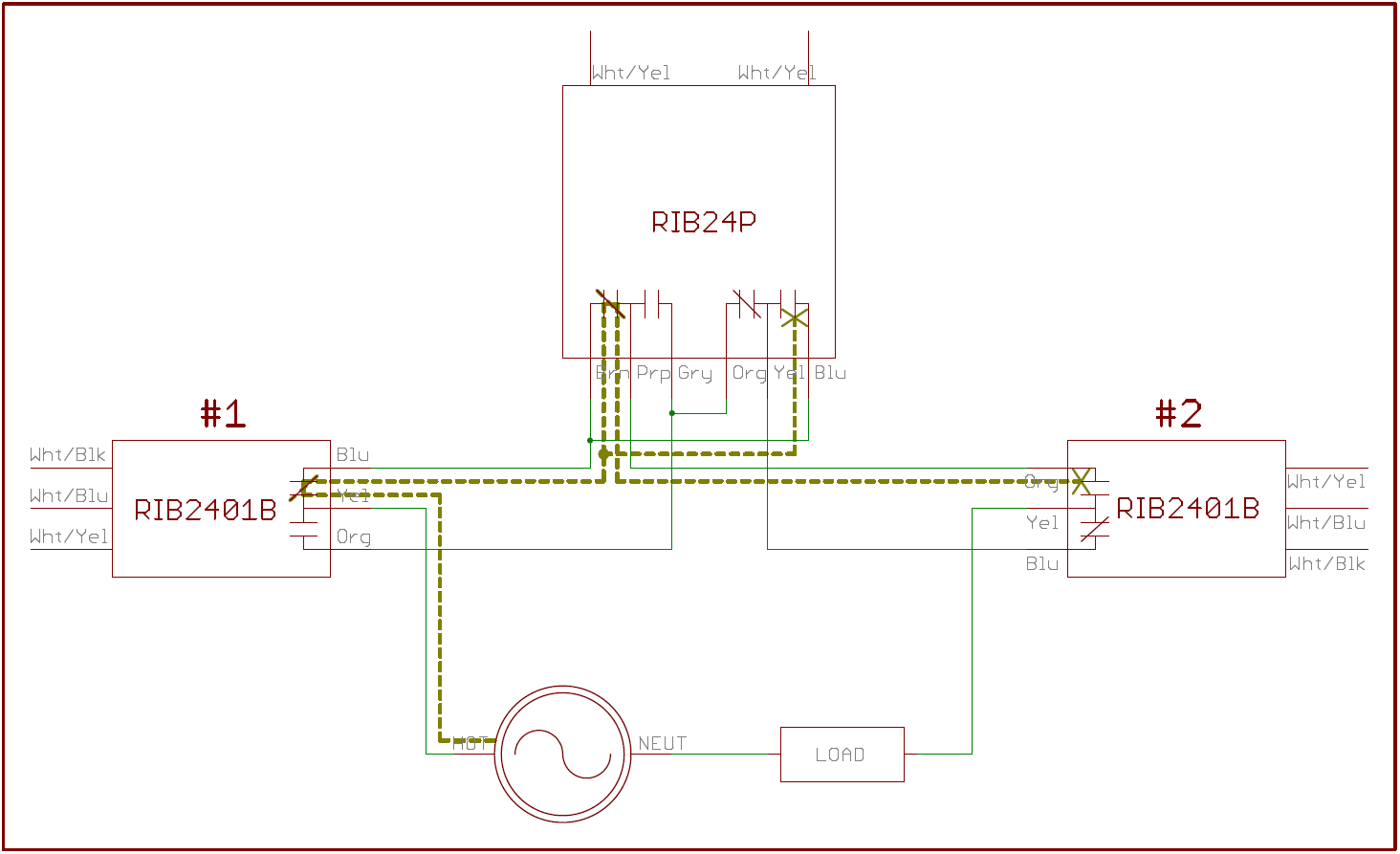
Again, the path from Source to Load has been interrupted, and the Load would be OFF. If either Relay #1 or #2 were to be energized at this point, the Load would toggle ON. The final Figure shows the path if RIB24P and Relay #2 are energized at the same time.
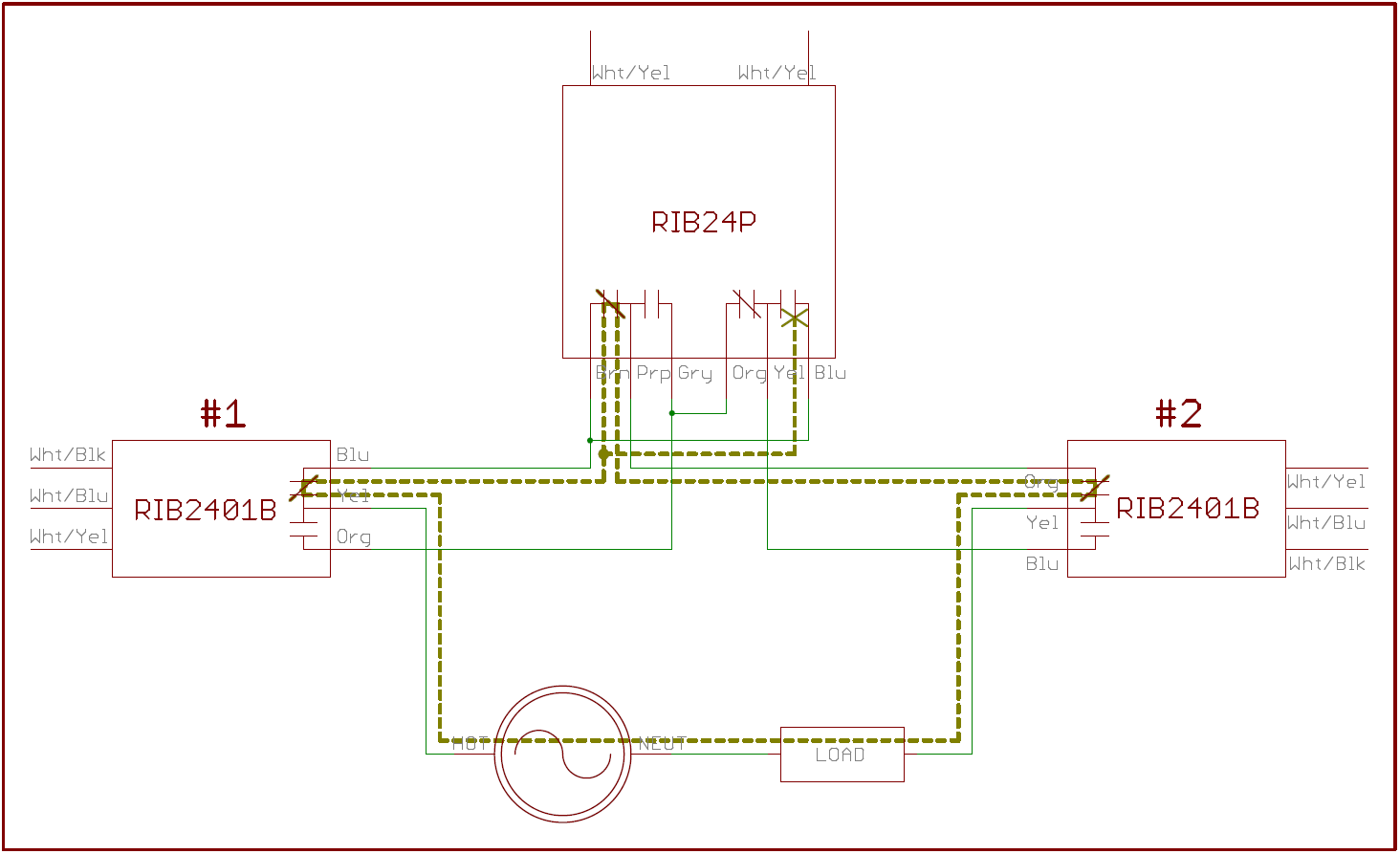
Cascading DPDT RIB Relays for Flexible Switch Control
When Relay #2 is energized, the N/O contact closes between the Org and Yel wires. The path from the Source to the Load is complete again, and the Load would turn ON.
Any number of DPDT relays can be cascaded together to add more switches to the setup above. There will always be two wires in (from the LINE side) and two wires out (to the LOAD side). Just make sure they are rated to handle the Load they are to control.
Benefits of Using RIB Relays for 3- or 4-Way Switching
Using RIB relays in place of traditional multi-way switch wiring offers several advantages:
- Simplified Wiring. Eliminates the need for multiple traveler wires, reducing installation complexity.
- Lower Labor Costs. Fewer conductors and connections mean faster installs and less troubleshooting.
- Increased Reliability. Relay-based switching removes mechanical wear points found in standard switches.
- Flexible Control Options. Integrates easily with automation systems, sensors, or low-voltage triggers for even more control flexibility.
Whether you’re upgrading an existing installation or designing a new system, RIB relays streamline control and reduce long-term maintenance.
FAQ: RIB Relays for 3- or 4-Way Switching
Q: What loads can RIB relays handle in a 3- or 4-way setup?
A: Depending on the model, RIB relays can handle lighting, HVAC, and motor loads. They’re available in various amperage ratings, making it easy to choose the right one for your application.
Q: Do I need special tools or programming to use a RIB relay?
A: No. Most RIB relays are prewired or include screw terminals for quick installation. They work with standard line- or low-voltage control signals.
Q: Will they integrate with automation systems or sensors?
A: Absolutely. RIB relays can be triggered by building automation systems, occupancy sensors, or time clocks for added flexibility.
Q: Are RIB relays rated for commercial or industrial loads?
A: Yes. Functional Devices offers models rated for lighting, HVAC, and motor loads, making them suitable for residential, commercial, and industrial applications.
Make the Switch to Functional Devices
RIB relays provide a smarter, cleaner, and more reliable way to implement 3- or 4-way switching. By reducing wiring complexity, increasing system reliability, and integrating easily with automation technologies, they bring long-term benefits to contractors, facility managers, and building owners alike.
Functional Devices has been designing and manufacturing dependable relays for decades. If you have an unusual application and want to know how you can use relays to accomplish it, just give us a call, and we will help you figure it out.
About Functional Devices, Inc.
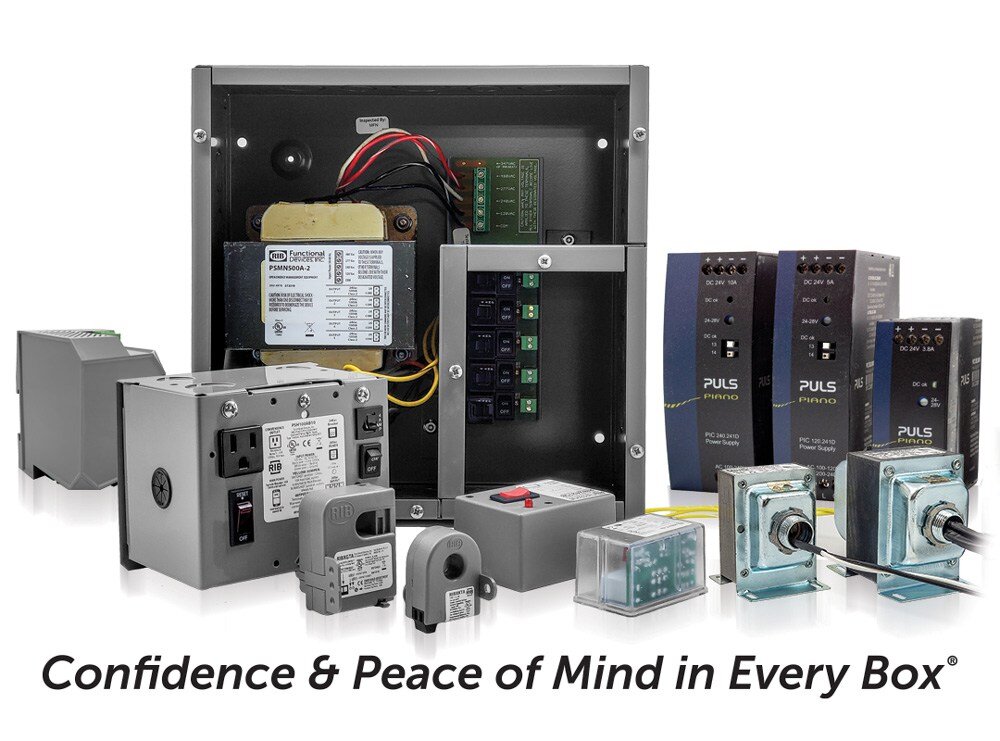
Functional Devices, Inc., located in the United States of America, has been designing and manufacturing quality electronic devices since 1969. Our mission is to enhance lives in buildings and beyond. We do so by designing and manufacturing reliable, high-quality products for the building automation industry. Our suite of product offerings include RIB relays, current sensors, power controls, power supplies, transformers, lighting controls, and more.
We test 100% of our products, which leads to less than 1 out of every 16,000 products experiencing a failure in the field.
Simply put, we provide users of our various products confidence and peace of mind in every box.

